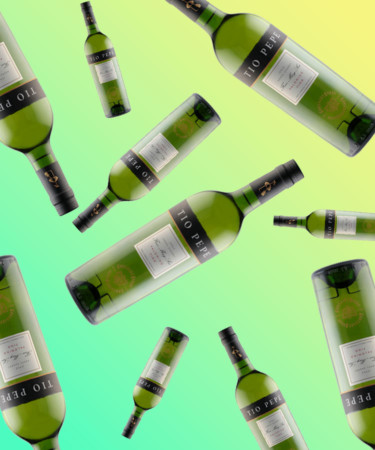Whether you consider yourself a bonafide sherry fan or are just sherry-curious, it’s hard to deny Tío Pepe’s popularity in the fortified wine category. Tío Pepe’s roots can be traced all the way back to 1835, when its parent winery, González Byass, was first founded. Today, it’s still run by the González family, whose sixth generation oversees the company’s now international reach.
For those unfamiliar with Tío Pepe Sherry, it may be helpful to think of it as something closer to a very dry white wine, as it differs greatly from classic dessert sherries like Pedro Ximénez. This is because Tío Pepe is a fino-style sherry bottled at a pale golden color, with notes of almonds, green olives, and green apples.
There’s plenty to learn about this legendary fave that’s long celebrated family — and was enjoyed by Picasso — so read on to learn the 10 facts you should know about Tío Pepe.
It’s an Extra-Dry Sherry.
Tío Pepe is best known for its classic fino-style sherry, which is the driest and palest form of sherry on the market. Unlike its competitors, fino is consumed at a fairly young age so it can be enjoyed without the prominent sweetness that appears in older styles.
It’s Made from 100 Percent Jerez Superior Grapes.
Tío Pepe is not only fino sherry but Jerez fino sherry. This style boasts a stronger flavor because it is aged beneath a thinner layer of flor (a protective yeast) than other finos. The Regulatory Council requires that only 60 percent of the grapes used in a Jerez fino sherry come from the Jerez Superior Zone, but 100 percent of the grapes used in Tío Pepe come from Jerez Superior.
Tío Pepe Is Named After Family.
In 1835, Manuel Maria González founded González Byass, a collection of wineries that includes the Tío Pepe Sherry house. He began the company with the help of his uncle, Jose Angel, who was an avid sherry lover with ample winemaking experience. Jose’s favorite style of sherry was fino, so González went on to name his fino sherry “Tío Pepe” after his uncle — as “Pepe” in Spanish is the nickname for Jose.
The Original Tío Pepe Had His Own Private Cellar.
While Uncle Jose, or Tio Pepe, helped his nephew start the company he didn’t officially work for González Byass, or get paid. Instead, he simply asked for somewhere he could go with his friends to drink his favorite sherry. His nephew obliged and built him the Tío Pepe Rebollo cellar, where Tío Pepe En Rama is still aged today.
There’s a Special, Unfiltered Version.
Tío Pepe En Rama first launched in 2009. En Rama means “straight from the cask” and signifies a style without clarification or filtration. After tasting the sherry straight from the barrel, The U.K. Wine Society requested a batch be bottled straight from the barrel. The first batch was sent to the U.K. as Tío Pepe En Rama and it sold out in two days. Now the wine can be found internationally.
There’s a Kosher Version.
In addition to classic Tío Pepe variations, oenophiles can also find Tío Pepe Kosher. Its entire production — from grape growing to vinification to bottling — is certified Shomer Shabbat in accordance with the talmudic laws. Even the yeasts used are procured from a different source (Kosher wines) but the winemakers insist the classic and kosher versions remain very similar. The main difference is that Tío Pepe Kosher offers a fuller body because the exclusive solera used limits rotation.
Fans Like to Think of It as White Wine.
Over the years, fans have promoted Tío Pepe as a close alternative to dry white wine. This has led to great success for the brand because its flavor profile is so far from the nutty sweetness of many classic sherries. In fact, in 1844, the first recorded mention of fino sherry was written in a letter by Robert Blake Byass to Manuel Maria González in which Byass commented on the “very, very pale wine” that González had recommended.
It’s Great for Dinner Parties.
Tío Pepe is excellent when served alongside food, and pairs well with canapés, tapas, seafood, and even ramen. Because of its delicate structure, most pros suggest consuming it in one sitting — but it can be re-corked and refrigerated for up to a week from opening.
The Brand Was the First Registered Trademark in Spain.
In 1936, Tío Pepe became the first registered trademark in Spain, which helped build the brand into an international icon. Today, the Tío Pepe neon reigns over the main square in Madrid, and remains one of only three neon signs allowed in the city.
It’s Beloved by Famous Artists.
In 2005, Spanish fashion designer Ágatha Ruiz de la Prada designed a colorful bottle for Tío Pepe, joining a list of famous designers who have recreated the silhouette with their own designs. According to González Byass, there are even images of Pablo Picasso with bottles of Tío Pepe in his studio.
